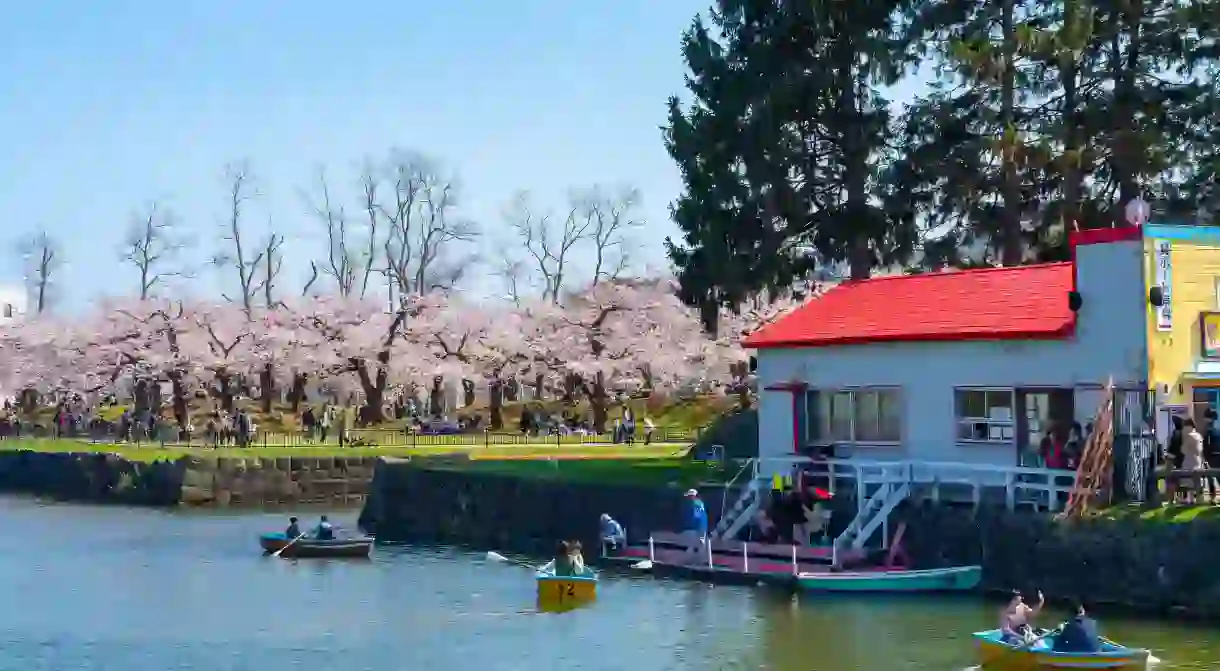The Biggest Seasonal Festivals in Hakodate, Japan

Few places in Japan feel the four seasons as keenly as Hokkaido, with sunny summers making way for seriously frigid winters. The weather in the port city of Hakodate is reflected in a crowded cultural calendar brimming with festivals in every month of the year.
Hakodate’s Port Festival headlines the list, but this celebration of summer – and its signature squid dance – is just one of southern Hokkaido’s flamboyant festivities. Samurai parades, open-air theatres, Christmas markets and flower festivals make sure that Hakodate never has to wait long for a party. Read on for our run-down of the biggest festivals in Hakodate, Japan.
Summer
Do the squid dance at the Hakodate Port Festival
The Port Festival is Hakodate’s biggest, making one very silly dance famous across Japan. Held across five days in early August since 1935, this summer celebration kicks off with a huge fireworks display on the first evening – grab a spot on the waterfront around the bay, or jostle for a spot on the top of Mount Hakodate (open until 10pm). On days two and three, dance parades shimmy through the streets, attracting 20,000 costumed performers. Their most popular moves are the squid dance (ika-odori in Japanese) – a wobbly-limbed jig that the crowd joins, accompanied by an equally simple chant: “Ika-ika-ika-ika-ika-odori!” (squid squid squid squid squid dance!) Different teams accompany neon-lit floats, while fresh-caught squid is the staple of many meals cooked up by the street stalls that pop up across the city at this time of year.
Other summer festivals
Like the rest of the country, Hakodate’s festival calendar is busiest during the warmer months. The open-air theatre at Goryokaku fort has been filling July and August weekend evenings since 1988, showcasing plays that trace the city’s history from its indigenous Ainu origins to the opening of the port and the massive fires that changed the cityscape. On the first Sunday in July, 8,000 runners conquer the scenic coastal course for the Hakodate marathon. Marine Day – the third Monday in July across Japan – is marked in Hakodate with a fireworks display from the man-made Midori no Shima (Green Island) in the harbour. After the Port Festival, the World Music and Dance Festival in early August transforms Motomachi Park in front of the opulent Old Public Hall with four stages, street performers and food stalls. Then the end of summer is signalled by the fireworks show in Yunokawa Onsen, a pyrotechnic tradition dating back to the early 1700s.

Autumn
See the maple trees at Autumn Leaves Festival
Kosetsuen Park, also known as Miharashi Park, beams red during fall, when the maple trees lining the paths of the Iwafune family’s old estate change colour. The bright red leaves and the traditional Japanese architecture is illuminated every evening until 9pm during the Autumn Leaves Festival (October and November), alongside live music and arts-and-crafts tutorials.
Earlier in autumn, the Hakodate Seibu chiku Bar-Gai festival infuses early September with the flavours of Spain, thanks to 70 food outlets at the foot of Mount Hakodate plus performers on street corners. The same event takes place in April, too. A week later, the Hakodate Gourmet Circus is the city’s biggest food event – tents line the streets to feed almost 200,000 hungry visitors with cuisine from every corner of the planet.

Winter
Ride snowmobiles at Onuma Hakodate Snow and Ice Festival
North of Hakodate, the Onuma Quasi National Park’s vast lakes and volcanic peaks are worth a visit at any time of year. That said, early February is particularly special when this winter carnival rolls into the reserve. The centrepiece is a 20-metre (65.5-foot) ice slide, surrounded by snowmobile rides, go-karts, ice sculptures and pond fishing on the frozen lakes. Summer in the shadow of Mount Komagatake is also a treat, and the Onuma Lake Festival has been making the most of it since 1906. Fireworks and lanterns light up the water, and there are music and dancing.
Winter illuminations and Christmas markets
Fitting for a city dotted with Christian churches built by the European merchants who arrived in the 1850s, Hakodate observes Christmas with a towering tree floating next to the Red Brick Warehouse precinct throughout December. In the glow of its 50,000 lights sit a string of bayside stalls scooping up steaming bowls of soup to cut the winter chill.
In mid-February, there’s another huge fireworks extravaganza for three straight evenings – the pyrotechnics dazzle against the black winter sky and Hakodate’s blanket of snow. And lights also illuminate the Goryokaku fort from the start of December to end of February – the frozen star-shaped moat is particularly impressive from the observation deck of the 107-metre (351-foot) Goryokaku Tower outside – as well as the European boulevards of Motomachi over the same period. Thousands of fairy lights twinkle from 5pm to 10pm every evening around the churches, the Old Public Hall and bayside slopes like Hachimanzaka and Nijukkenzaka.

Sakura season
Sakura bloom in Hakodate each May, and Goryokaku – the 19th-Century European fortress converted into a public park lined with cherry trees – and Hakodate Park – a small, inner-city park at the foot of the mountain – are the two main cherry blossom spots, especially when barbecues blaze beneath the flowers in both locations.
East of Hakodate, the foothills of the Mount Esan volcano are ablaze with an even brighter pink petal. Azaleas blossom from late May to early June at the base of this rugged volcano, creating a sea of bright pink that’s celebrated with a food and music festival on the last Sunday in May. The Hakodate Goryokaku Festival is also celebrated in May, when parade-goers dress up in samurai uniforms to commemorate the 1869 battle between feudal forces and the imperial army that ushered in a new era in southern Hokkaido.














